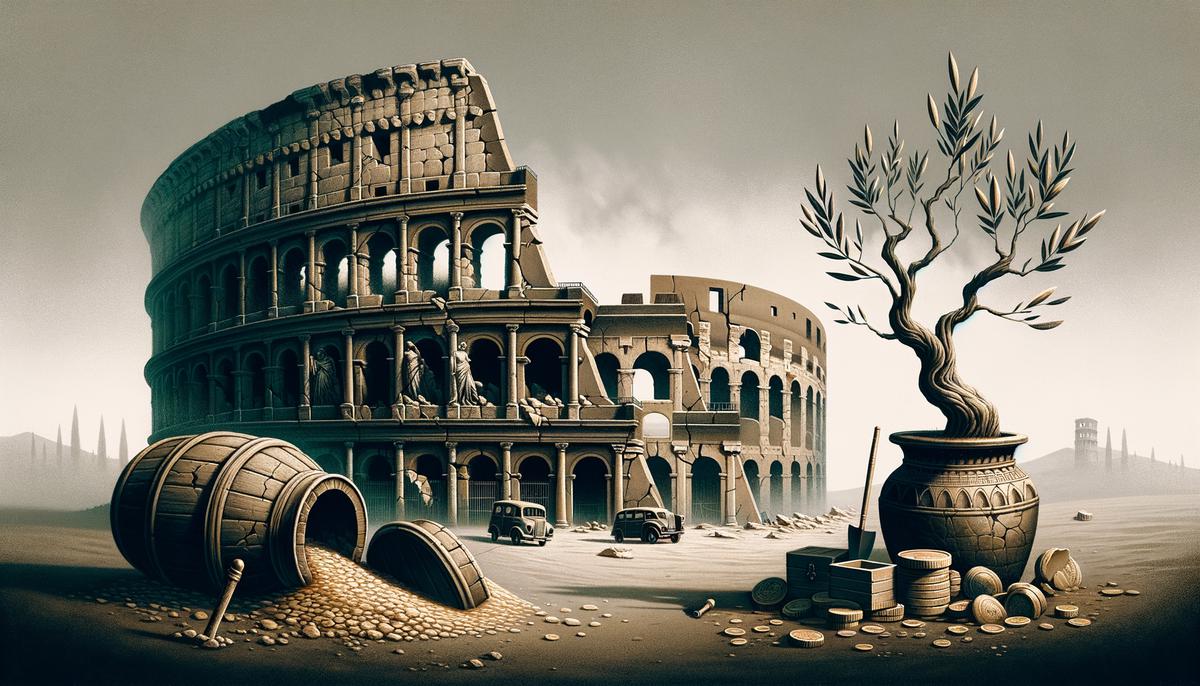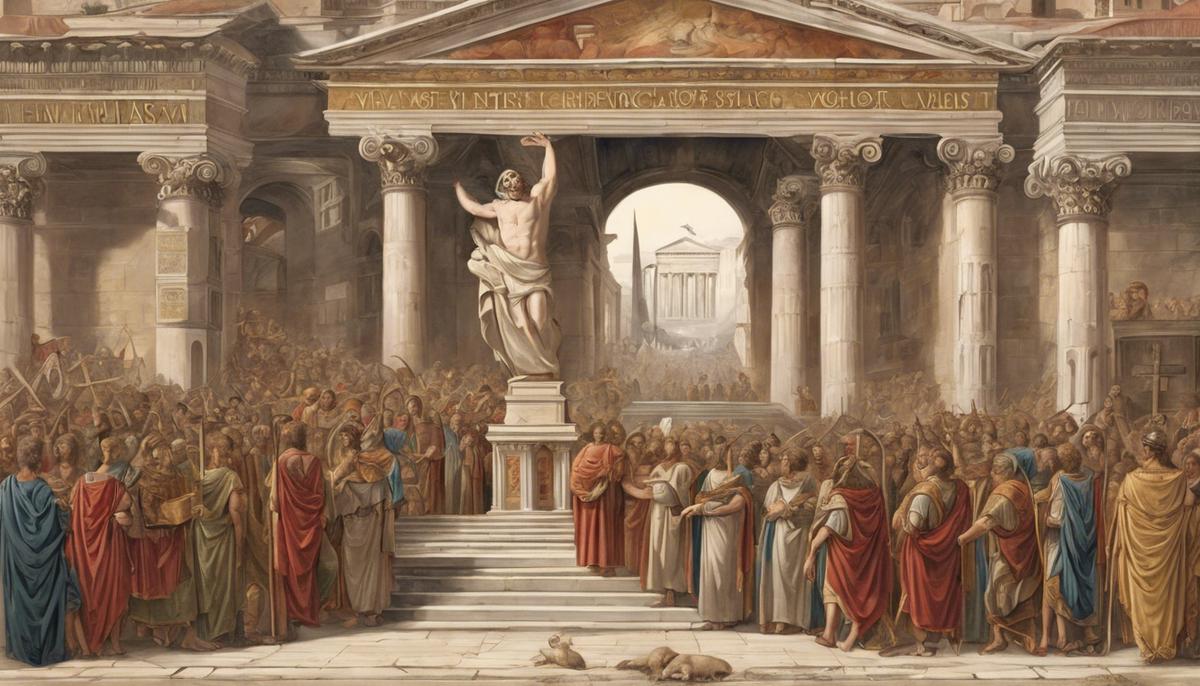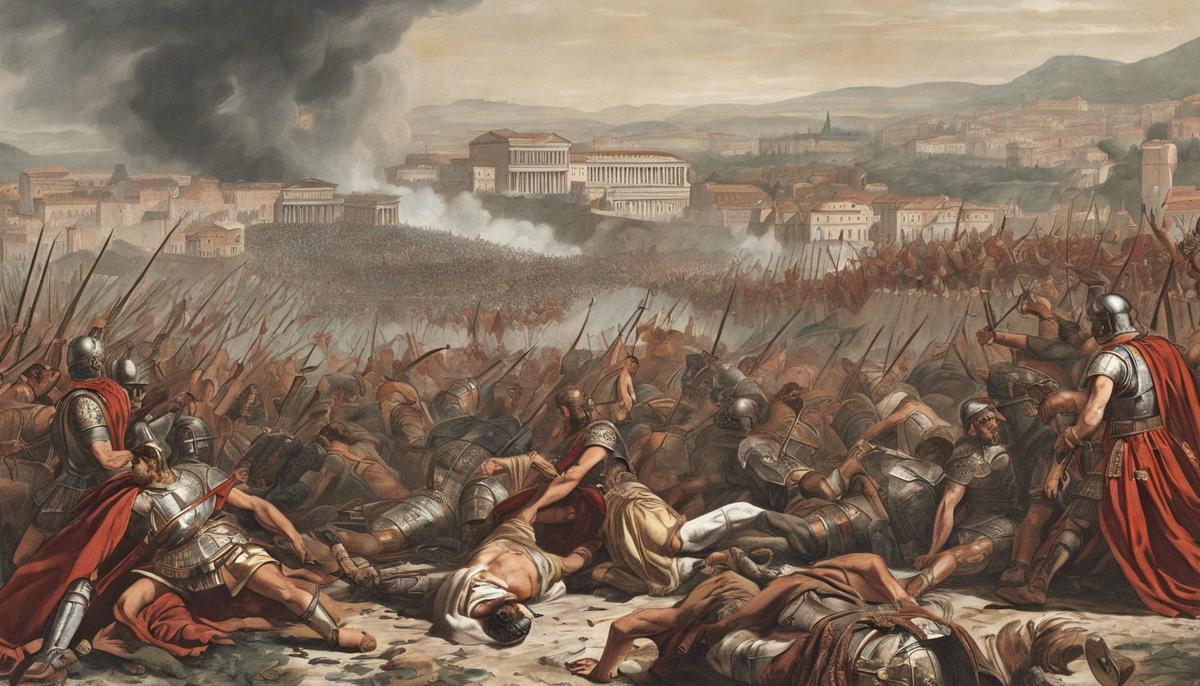Economic Decline
The Roman Empire's financial wellbeing began to wobble as it faced incessant warfare. This created a deep hole in the Empire's coffers, funds that were nearly impossible to refill as peace became a distant memory. Wars weren't cheap then, and certainly not for Rome, which found itself engaged on multiple fronts. The more territories Rome acquired, the more resources it drained to keep them under control and to defend its vast borders. This military overspending sparked a financial firestorm that was hard to extinguish.
To complicate matters, reliance on slave labor caused its own set of problems. Rome's economic engine hummed on the back of slaves. They worked the farms, crafted goods, and even educated Roman children. However, as territorial expansion slowed by the second century and turned to a halt, the fresh influx of slaves dried up. This led to a labor shortage that pushed the empire into an even tighter economic corner.
Adding to the crisis, a severe financial problem emerged in the form of rampant inflation. This was largely due to the devaluation of Roman currency, an attempt to stretch the funds they had by producing more coins with less silver content. As the value of their money plummeted, prices soared. Suddenly, a loaf of bread wasn't so affordable. This economic imbalance hit the common Roman hard, widening the gap between the wealthy and the poor.
To dodge the burning grip of taxation, many wealthy individuals fled to the countryside. They established independently run estates, effectively snipping their financial ties to the crumbling urban economy. In isolation, they could evade the tax collector but left the empire's coffers even more barren.
Meanwhile, piracy and raiding by Germanic tribes disrupted trade routes, particularly those crossing the Mediterranean. This severed economic lifelines that Rome relied upon for both imports and exports. North Africa, a major source of Rome's grain supply, became a chess piece under the control of the Vandals. Their piracy hampered not just food supplies but also trade in general, slicing through the economic tendons of the Western Roman Empire.
The division of the empire into East and West under Diocletian sealed the fate of the Western Empire. While it was initially intended to make governance more manageable, it inadvertently drained resources from the West and rerouted them to fortify and enrich the East. Consequently, the Eastern Empire, or Byzantine Empire, thrived and continued for centuries, whereas the West fell into despair and disrepair, crumbling under its own economic struggles.
This storm of economic strife – inflation, a failing labor model, military overspending, interrupted trade, and internal power shifts – systematically dismantled Rome's internal strength. Slipping through these fiscal cracks, the might of Rome faded, leaving it vulnerable to external forces eager to capitalize on its weakened state.

Military Challenges
The transition from a robust, citizen-focused military to a band of mercenaries fundamentally undermined the Roman Empire's martial efficacy and morale. During its zenith, Rome's legions were celebrated across the ancient world for their discipline, loyalty, and fighting prowess. Such qualities were intrinsic because the soldiers were citizens defending their homeland. However, as the Empire expanded, so did the length of its borders and the diversity of threats it faced. This overextension spread the military thin, creating an unsustainable defensive posture against the endless waves of incursions.
In response to this predicament, the Empire began to outsource its military needs, relying increasingly on hired soldiers. These mercenaries brought with them a myriad of issues, not least of which were questions of loyalty and effectiveness. These forces often comprised individuals from the very barbarian tribes against whom Rome sought protection. Understandably, their allegiance was easily swayed by higher pay or the changing tides of conflict, a stark contrast to the unwavering loyalty expected of Roman citizens. It created a paradox where Rome's defenders could turn into its assailants without notice.
This shift greatly impacted Rome's ability to manage external threats. The Visigoths, Vandals, and Huns sensed and exploited this weakness. The Visigoths' sacking of Rome in AD 410 under Alaric I showcased a damning illustration of these military failures. Furthermore, as these tribes settled within the Empire's borders, they continued to weaken Rome's grasp on its territories, literally hollowing out the strength of the Empire from within.
Coupled with the economic strife, the military's inability to defend Rome's expansive borders expedited the Empire's decline. Emperors found themselves in a ceaseless struggle to secure enough resources to pay these mercenaries while also maintaining Rome's infrastructure and addressing internal dissent. The administrative challenge was immense – coordinating defense strategies across vast distances without the modern luxuries of quick communication and transportation. This logistical nightmare fractured Rome's once cohesive defensive strategy into disjointed skirmishes, leaving the empire vulnerable to concerted invasions.
Significant also were the cultural ramifications of this reliance on mercenary forces. The proud tradition of military service that defined Roman citizenship diluted as the empire increasingly placed its security in the hands of those who saw battle as merely a job. The cohesive identity and shared purpose that had fortified the legions' structural integrity dissipated, eroding one of Rome's foundational strengths.
In sum, the Roman Empire's military encounters paint a disheartening picture of a once invincible juggernaut reduced to a shadow of its former self, unable to wield its military in a way that could preserve its dominion. Facing multifaceted pressures from within and without, the collapse, in hindsight, seems less a sudden catastrophe and more a slow succumb to inevitable ailments exacerbated by time and external opportunism.
Political Instability
Political instability cascaded through the echelons of Roman governance with the same intensity as the barbarian invasions that pierced the empire's borders. The surging tide of emperors—often ascending to power only to be usurped or assassinated within mere months—sketched a grim picture of a crumbling political structure. The rapid turnover of rulers, a staggering 20 emperors within a 75-year stretch leading to the fall, hollowed the core of Roman authority, leaving it brittle in the face of both internal dissent and external pressures.
At the heart of much of this political chaos was the Praetorian Guard. Originally established as personal bodyguards for Roman emperors, their role evolved into kingmakers with the muscular force to install or depose leaders at will. This power they wielded was emblematic of the broader political disintegration faced by Rome. No clearer was their capabilities demonstrated than in the auction of the empire to Didius Julianus in 193 AD, a transaction that thrust into stark relief the profound corruption undermining the skeletons of Roman governance.
This whirlwind of political maneuvering was not simply a matter of palace intrigue but had palpable impacts on the realm's functionality and its citizens' lives. The frequent change in leadership meant a similarly frequent shift in policies, strategies, and priorities. This lack of consistency made coherent governance nearly impossible, leaving vital military and economic initiatives adrift in a sea of uncertainty. The governments cycled through emperors with bewildering rapidity leaving little room for any semblance of stable governance or long-term strategic planning, critical components for maintaining an empire of Rome's size and diversity.
Moreover, this instability infiltrated and weakened the bonds between Rome and its territories. The empire, sprawled across three continents, required a central figure of authority and a consistent set of policies to maintain cohesion and loyalty amongst its provinces. The rapid turnover of emperors ruptured these bonds, as local leaders found little incentive to remain loyal to a distant, ever-changing capital whose leaders showed more interest in their life expectancy than in the prosperity of their dominions.
Such political disarray also opened floodgates to corruption at all levels of administration. With emperors fleeting and the real power resting in the hands of military and bureaucratic elites, the system of governance became increasingly exploited for personal gain. This corruption undermined the authority and legitimacy of the central government even further, encouraging rebellion, dissent, and even indifference to the empire's fate among its populace and peripheral territories.
What emerges from this vortex of intrigue, assassination, and corruption is a vivid portrait of an empire collapsing under the weight of its own internal contradictions. The scale of governance demanded a cohesive, stable political structure capable of navigating external pressures and internal demands. Instead, what unfolded was a saga of fragmentation that corroded Rome's ability to orchestrate an effective response to its manifold crises. As the political gears ground to a halt against the iron weight of instability, so too did the machinery of the Roman Empire, yielding to entropy and the relentless march of time, factors that challenged the illusions of power and grandeur.

Cultural and Social Transformations
Within the labyrinth of Rome's seemingly tangible issues—military, economic, political—wove the more ethereal threads of cultural and social transformations. These shifts proved equally critical in precipitating the Empire's decline. The Roman state had long prided itself on a cohesive set of cultural norms and religious practices that went beyond mere tradition. They were the marrow of Roman identity. Yet, as the Empire swelled, encompassing a plethora of diverse cultures, its own core began to dissipate into a multicultural mosaic that while rich in diversity, challenged the unity of Roman identity.
Among the most significant of these seismic shifts was the rise of Christianity. The transformation from a polytheistic society, where the emperor was seen almost as a deity and traditional Roman gods permeated every aspect of life, to one embracing Christianity—a monotheistic religion denying the divine status of emperors—was monumental. This spiritual revolution didn't occur overnight but unfolded as a slow yet unyielding infiltration of Christian values into the heart of Roman society. By the time Constantine the Great legitimized Christianity in 313 AD with the Edict of Milan, the religion had already won over a substantial portion of Rome's populace. With the conversion of Constantine himself, the structures supporting Roman cultural and religious tradition began to visibly crumble.
The transition bore profound implications for Roman society. Christianity's ascent heralded a new era wherein loyalty shifted from state to church. The divergence of spiritual allegiance directly impacted the social order and political allegiance. Christian bishops and popes amassed considerable influence, often rivaling secular authorities. The assertion that Christianity fundamentally weakened Rome's military spirit, as suggested by some historical narratives, perhaps overstates the case. However, it is undeniable that the religion reshaped societal values and priorities, pushing beliefs that conflicted with established norms such as the glorification of military conquest.
Furthermore, the Christian ethos of a universal kingdom of God undermined the pax Romana—the peace of Rome—which had promised prosperity under Roman rule. The spiritual realm of Christianity offered a unity and peace beyond the temporal, diluting the urgency to preserve the physical empire. As the fabric of Roman tradition wore thin, so did the adhesive that bound the empire together. The ceremonies and spectacles, once crucial in reinforcing a common identity among Rome's populace, lost their luster as citizens increasingly found their communal belonging in the Christian congregation rather than in the polity of Rome.
Such drastic upheavals in Rome's cultural and spiritual landscape invariably contributed to the empire's fragmentation. While not as visible as military defeats or economic collapse, the erosion of shared norms and values removed yet another pillar sustaining the Roman state. As Christianity ascended, traditional Roman virtues and practices descended into obsolescence, leaving a society in search of new identities and loyalties. These transformations within Rome were not merely symptoms of its decline but active participants in its unraveling. The Empire needed more than soldiers, silver, and statutes to endure; it required a coherent sense of self, a unified identity. When these began to dissolve amidst the growing diversification of beliefs, so too did the cohesiveness that had once made Rome invincible.
As Rome's boundaries expanded, encapsulating varied cultures with distinct traditions and deities, the Empire's attempts to integrate these varying societies under one rule rendered its core identity increasingly porous. While the contagion of cultural and social shifts ebbed and flowed throughout centuries, contributing to Rome's complexion, it was the rise of Christianity that delivered the most poignant blow to Roman cohesion and identity. In this taut fabric of interwoven causes leading to Rome's demise, the threads of cultural transformation are as prominent as those of military defeats or political corruption—the tapestry of decline is intricate, and its patterns are manifold.

Division of the Empire
The bifurcation of the Roman Empire into its Western and Eastern provinces charted a new geographical and administrative course that sowed the seeds of discord and division, ultimately weakening the structural integrity of this historic empire. The decision, enacted by Emperor Diocletian in the late 3rd century, aimed to address the Empire's expanding complexities and mounting crises through decentralization. This division promised a more agile and responsive governance structure tailored to the distinct needs of its sprawling territories. However, it inaugurated an era of divergence where unity of command and purpose gradually gave way to fragmented sovereignties.
Diocletian perceived his creation of the Tetrarchy, splitting rule among four emperors to reign over the empire's quadrants, as a solution for the empire's burgeoning administrative demands and power struggles. Although this epoch boasted brief moments of stability, it inadvertently fostered a competitive atmosphere among Rome's highest echelons. The political chasm widened upon Constantine the Great's reversion to sole emperorship, choosing Byzantium (later Constantinople) as the empire's new power center. This pivot eastwards entailed a substantive reallocation of the empire's military, economic, and bureaucratic resources to the Eastern provinces. Romans of the West watched as attention and investment flowed towards the wealthier, less militarily-pressed East, creating a dichotomy of prosperity and neglect.
As centuries unfolded, the estrangement between the Eastern and Western halves grew more pronounced. The practicalities of governance and military logistics favored local administration, but the rivalry prevented genuine cooperation in the face of external threats. Where unity was essential, division prevailed. The West, depleted of resources and military might, found itself losing territories to barbarian tribes, while the East fortified its positions, eventually transforming into the Byzantine Empire that would endure another millennium.
Moreover, this division permeated beyond fiscal and military domains into the very social fabric of the empire. Linguistic and cultural divergences deepened, crafting distinct identities that further eroded the ties binding the Roman world. The Latin-speaking West looked towards Rome's ancient republicanism and glories, while the Greek-speaking East evolved around Byzantine autocracy and Orthodox Christianity. The Western decline was not merely due to economic depredations or military usurpations but loss of the cohesive Roman identity that could galvanize disparate peoples under a singular banner.
What Diocletian perhaps underestimated was that Rome's strength had always been its ability to assimilate and align various cultures, religions, and ethnicities towards an encompassing Roman ideal. The division of the empire significantly weakened this ability, transitioning from a model of integration to one of fragmentation.
The division of the empire emerges as a pivotal factor leading to its unraveling. This strategic bifurcation, intended to streamline governance and address burgeoning crises, inadvertently sowed seeds of discord and division. It exemplified how a decision aimed at strengthening the empire's foundations instead eroded its cohesion, leaving the Western Roman Empire exposed to challenges it could no longer withstand. The division stands as a testament to the unintended consequences of strategic decisions, marking a decisive moment in the Roman Empire's journey from zenith to nadir.

Leave a Reply